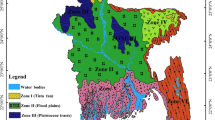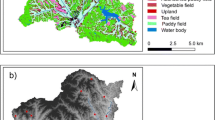Abstract
During the last two decades, nitrate nitrogen (NO3-N) concentrations in groundwater in Japan have increased steadily due to the development of intensive agriculture. In some areas, they have reached or even exceeded the unacceptable level for drinking water, 10 mg l−1. In 2000, the Environment Agency showed that 5.6% (173 of 3,374) tested wells and 4.7% (64 of 1,362) wells used for drinking water exceeded the standard level in 1999. The highest value of NO3-N in the wells was 100 mg l−1. Many researches have shown that NO3-N pollution of groundwater was widely observed in Japan, except the paddy field regions. Farming practices in Kagamigahara city of Gifu prefecture have been typical ones for reducing NO3-N pollution in groundwater. In the east district of the city, NO3-N concentration was low in 1966, but reached 27.5 mg l−1 in June, 1974. The farmers in this district began to reduce the nitrogen fertilizers in carrot cultivation, going from 256 kg N ha−1 in 1970 to 153 kg N ha−1 in 1991. The use of controlled release fertilizer increased fertilizer-nitrogen efficiency compared with common compound fertilizer and NO3-N concentration in the groundwater began to decrease steadily. It was discussed that in order to decrease the NO3-N pollution of groundwater, it is necessary to refocus not only agricultural technology but also agricultural policy, toward sustainable agriculture and rural development.
Similar content being viewed by others
References
Addiscott TM (1996) Fertilizers and Nitrate Leaching. In: Hester RE & Harrison RM (ed) Agricultural Chemicals and the Environment, pp 1–25. Issues in Environmental Science and Technology, Number 5, The Royal Society of Chemistry, Cambridge, U.K.
Bogardi I & Kuzelka RD (ed) (1991) Nitrate Contamination, Exposure, Consequence, and Control, Berlin Heidelberg, Germany, Springer
Burt TP, Heathwaite AL & Trudgill ST (ed) (1993) Nitrate, Processes, Patterns and Management, Chichester, England, Wiley
Chino M (1999) Report of the study group on the recycling of organic wastes in Japan (in Japanese)
Environmental Agency (1998) State of environment 1998, Environmental Agency, Japan (in Japanese)
Environmental Agency (2000) Report on the nitrate concentration in the groundwater, Environmental Agency, Japan (in Japanese)
Follett RF (ed) (1989) Nitrogen Management and Ground Water Protection, Amsterdam, The Netherlands, Elsevier
Follett RF, Keenery DR & Cruse (ed) (1991) Managing Nitrogen for Groundwater Quality and Farm Profitability, Soil Science Society of America, Inc., Madison, USA
Fujii K, Okamoto R. Yamaguchi T, Ohoshima H, Ohomasa K and Shibano A (1997) Data on the groundwater quality in the rural area in Japan (1986–1993), Miscellaneous publications of the Institute of Agro-environmental Sciences No. 20, 1–329 (in Japanese)
Hidaka S (1987) Groundwater pollution in the Kushibiki plateau. In: Research on the conservation of water quality in the agroecosystem (Report of the Agri. Forest. Fish Sci. Counc.) 46–53 (in Japanese)
Itokawa S (1997) Movement of fertilizer nitrogen in greenhouse fields and nitrate nitrogen concentration of groundwater. Jap J Soil Sci Plant Nutr 327–330 (in Japanese)
Kagamigahara city (2000) Report of the Division of Agricultural Production, Kagamigahara city, Gifu prefecture, Japan (in Japanese)
MAFF (1991) Report on the quality of groundwater used in irrigation, MAFF, Japan (in Japanese)
MAFF (1995) Data from the Bureau of Agricultural Production, MAFF, Japan (in Japanese)
MAFF (1999) Survey data on agricultural production, Department of Statistics, MAFF, Japan (in Japanese)
Mochida H (2000) Estimation of nitrogen balance in upland crops, Report of Kyushu Agri Expt Sta (in Japanese)
Nagai S (1991) Hydrological studies of groundwater pollution with inorganic compounds. J Hydrology 33: 145–154 (in Japanese)
Ogawa Y (2000) Nitrate pollution of groundwater and change of agricultural practice. Tokyo, Nobunkyo Pub. Co. (in Japanese)
Owa N (1998) Nitrogen balance between output by crop and input of the chemical fertilizer, Report for the meeting of Soil Sci. and Fertilizer research in Kanto-Tokai district (in Japanse)
Yoshiba M, Aso S and Takenaga H (1995) Nitrate pollution of the groundwater in a suburban region — A case in Iseharacity, Kanagawa Prefecture. In: Kumazawa K (ed) Report of the Research Fund of the Science Research of the Ministry of Education, Stable Isotopic Studies on the Environmental Pollutants, 181–198 (in Japanese)
World Health Organization (1970) European Standards for Drinking Water, 2nd edition, WHO, Geneva
Author information
Authors and Affiliations
Rights and permissions
About this article
Cite this article
Kumazawa, K. Nitrogen fertilization and nitrate pollution in groundwater in Japan: Present status and measures for sustainable agriculture. Nutrient Cycling in Agroecosystems 63, 129–137 (2002). https://doi.org/10.1023/A:1021198721003
Issue Date:
DOI: https://doi.org/10.1023/A:1021198721003




